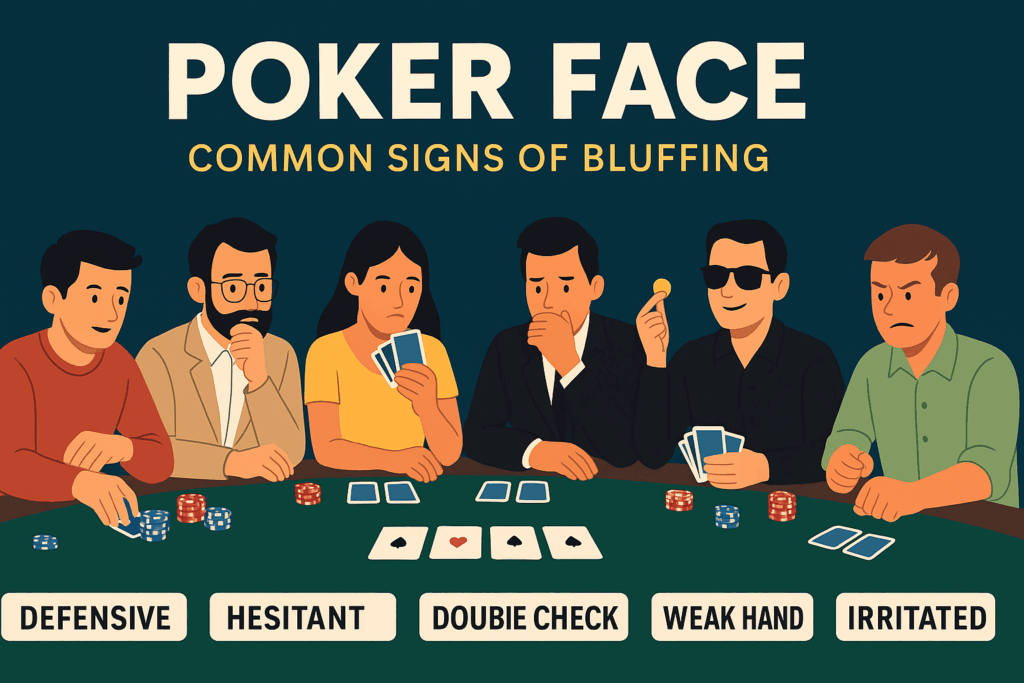
Poker Face: 7 Common Signs of a Bluff in Poker
Published by Brett Chatz on April 19, 2023

Published by Brett Chatz on April 19, 2023
Bluffing is an art form in poker. Whether you’re playing online or in a land-based casino, the ability to deceive — or detect deception — can make or break your game. A great poker face isn't just about a blank stare; it's about controlling your behavior and reading the cues of others.
In this guide, we’ll uncover the most common tells players unknowingly reveal when bluffing — and how you can use that knowledge to gain the upper hand.
🎭 What Is a Poker Face?
A “poker face” refers to a neutral expression and body language designed to conceal your hand strength. But while some players master this skill, others give away subtle cues — especially when bluffing.
Bluffing itself is not reckless — it’s strategic. But overuse or emotional tells can make even the boldest move backfire.
⚠️ 7 Common Signs of a Bluff in Poker
1. The Defensive Bluff
When a player with a weak hand acts overly assertive — betting quickly or grabbing chips fast — it’s often an attempt to scare opponents off. Confident players with strong hands usually take their time.
Tip: Watch for speed. Overeager moves are often cover-ups.
2. The Hesitant Bluff
Sudden pauses, nervous glances, or uncertain betting may signal discomfort. A hesitant check or quick call may hide a weak hand — or attempt to induce raises.
Tip: Track how long a player takes to act and compare it round to round.
3. The Double-Check Bluff
Looking back at hole cards more than once — especially before a raise — is suspicious. Skilled players know their hand. Extra peeking often means second-guessing.
Tip: Frequent double-checking often equals doubt.
4. The Weak-Hand Speech Bluff
Comments like “I’ve got nothing” or “Let’s see what happens” are often reverse psychology. Downplaying strength is a classic bluffing tactic — designed to bait bets.
Tip: Listen as closely as you look.
5. The Goading Bluff
Trash talk or verbal nudging to raise the stakes can be manipulation. In online poker, this may happen in chat rooms. On live tables, it’s body language and banter.
Tip: Watch for players who try too hard to control the tempo.
6. The Irritated Player Bluff
Frustration and irritation are sometimes genuine — but sometimes not. An annoyed player might be trying to sell weakness… or they’re actually steaming after a bad beat.
Tip: Read emotional patterns, not just one-off reactions.
7. Sudden Stillness or Fidgeting
Physical behaviour swings — either becoming too still or suddenly restless — can signal bluffing. Most people aren’t aware of how their posture shifts under pressure.
Tip: Compare their current energy to their default behaviour.
👁️ How to Practice Reading Bluffs
- Play with new people to challenge your observation skills
- Join low-stakes online games with chat features to watch behavioural cues
- Watch recorded tournaments and focus on player reactions post-flop
- Take notes: tracking patterns builds insight over time
💡 Bonus: When You Should Bluff
Bluffing is part timing, part reputation. Here are smart bluffing conditions:
- Opponents are tight and risk-averse
- You’re on the button with a late-position advantage
- You have a draw that may or may not be completed
- You’ve built a tight image throughout the game
Pro Tip: Less is more. Bluff sparingly — unpredictability is your real weapon.
🎓 FAQ: Bluffing in Poker
Q: Are tells reliable?
A: They’re clues, not guarantees. Use them in combination with betting patterns and history.
Q: Can bluffing work in online poker?
A: Yes. Watch betting speed, timing, and chat behavior instead of body language.
Q: Do pros bluff a lot?
A: Not as often as you think. Pros rely more on math, position, and reads — bluffing is selective.
Q: Should I bluff as a beginner?
A: Occasionally, but focus more on fundamentals until you can read the table better.
🔚 Final Thoughts
Whether you’re playing Texas Hold’em or Omaha, understanding how to read — and control — bluffing behavior is essential to long-term poker success. The more observant you become, the more profitable your decisions will be.
At Casinofy, we offer strategy guides, poker tutorials, and honest reviews of top poker sites. Ready to sharpen your edge? Explore our online poker page and take your game to the next level.









